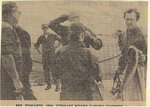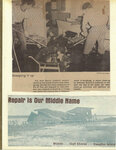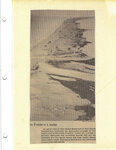Gulf Coast residents likely remember the names Sally, Ivan and Frederic, depending on how long they have lived on the Alabama Gulf Coast.
This week's Hurricane Francine's landfall to the west of …
This item is available in full to subscribers.
Please log in to continue |







Gulf Coast residents likely remember the names Sally, Ivan and Frederic, depending on how long they have lived on the Alabama Gulf Coast.
This week's Hurricane Francine's landfall to the west of Baldwin County in Louisiana Wednesday is a reminder that September is also National Preparedness Month, the time of year hurricane season reaches its peak.
Gulf Coast Media pulled together an overview of hurricane history using data from the National Oceanic and Atmospheric Administration (NOAA), the National Weather Service (NWS), personal accounts and other sources to provide a clearer understanding of the risks posed by these storms.
September is the most common month for hurricanes to make landfall in Alabama.
"Of all the recoveries I managed, I must say natural disasters are a different management than that of the oil spill," said Amelia Fletcher, director of servant ministries at Gulf Shores Methodist Church, who served as conference disaster coordinator for the Alabama-West Florida Conference for 15 years. "It is heartbreaking to go through homes with homeowners and pick through muck and debris to find one salvageable memento of their lives so full the day before. A piece of china, a cracked picture frame, a souvenir of a trip long past. The power of wind and water teach us valuable lessons of what is truly important... and that the most cherished things we own are in our family, friends and hearts."
This was one of the deadliest and costliest hurricanes in U.S. history, according to reports. Making landfall as a Category 4 in Miami on Sept. 18, it devastated the region before continuing its destructive path across Florida. The storm made a direct hit (when the eyewall hits land but the eye does not) in Florida before making a true landfall (when the eye hits land) in Alabama on Sept. 20.
The hurricane caused approximately $100 million in damages (equivalent to over $1 billion today) and left thousands homeless. After crossing Florida, it regained strength and tracked toward the Gulf Coast. Storm surge and heavy rains caused significant damage to coastal towns and agricultural assets before dissipating over Mississippi two days after landfall,
Hurricane Frederic stands as one of the most destructive storms to hit the Gulf Coast. A powerful Category 3, Frederic made landfall at Dauphin Island on Sept. 12, packing sustained winds of 130 miles per hour.
Damages reached $1.77 billion — making it one of the costliest hurricanes at the time. The storm also marked a significant moment in federal disaster response, with the newly formed Federal Emergency Management Agency (FEMA) stepping in to provide nearly $250 million in aid, largely directed to Alabama. In the aftermath, Frederic spurred changes in local building codes and strengthened disaster preparedness measures to reduce future risks.
Fletcher's grandmother lived through Frederic and lost everything, as many others at the time did.
"The motto of the community was 'repair is our middle name,'" Fletcher said. "…I would say 'we are ever resilient.'"
She recalled Gulf Shores Methodist Church serving as a hub for emergency response, with helicopters landing on the north lawn as Gov. Fob James coordinated recovery efforts.
Joy Stewart, a Baldwin County native, was 23 when Frederic hit.
"…it was a very scary experience," Stewart said of living through her first major hurricane. " We lived in Summerdale, and me, my husband and his mom evacuated to her brother's home in Eight Mile, Alabama, in Mobile County, and that, too, wasn't far enough to go to get out of Frederic's path."
Stewart recalled the tense moments as Frederic tore through the house.
"Most of the homes at that time in the '70s had those metal wind turbines on the roof," she said, "and one was ripped off the house, and rain was pouring into the attic, so my husband had to crawl in there to patch it up as well as possible all while a monster hurricane was hitting outside."
The storage shed in the backyard was torn apart and blown away, while a tall pine tree was uprooted and slammed onto the roof of the house.
"Luckily, it didn't crash through the roof, so the damage to his home wasn't too bad," she said.
The aftermath of the storm was equally harrowing with Stewart unsure if their home made it through the ordeal.
Going home the next day, a trip that would normally take about an hour, was a three-hour drive.
"There were broken power poles everywhere and power lines down on the highway all along I-10," she said, "and bumper-to-bumper traffic with people trying to make it back to their homes, so it was very slow going."
Despite the chaos, they were relieved to find her mother-in-law's wood-frame farmhouse still standing, with minimal damage.
"One piece of plywood had blown off a side window in the living room, so some rain got in, but nothing significant," she added.
But for Gulf Shores, where Stewart had spent much of her childhood, the scene was one of devastation.
"Gulf Shores, on the other hand, suffered significantly and was pretty much wiped, out and the landscape there was altered and changed forever," Stewart recounted. "The Gulf Shores and beaches I grew up with were and are no longer in existence."
In the summer of 1997, Hurricane Danny became a stark reminder that even smaller storms can leave a lasting impact.
Danny made landfall near the mouth of the Mississippi River in late July and slowly inched its way toward the state's Gulf Coast. According to reports, it was the only hurricane to make landfall in the United States during the 1997 Atlantic hurricane season and the second hurricane and fourth tropical storm of the season.
The storm's 80 mph winds may have been less fierce compared to others, but the relentless rain proved to be the biggest threat. Its sluggish pace allowed it to dump enormous amounts of rain — nearly 37.75 inches on Dauphin Island.
Flash flooding ravaged areas along the Fowl and Fish rivers. Dauphin Island and surrounding areas were especially hard-hit, with homes and businesses submerged, power outages lasting for days and entire communities left stranded.
"We didn't live near any water, so we were fortunate and didn't get any damage to our property," said Stewart, who stayed home in Summerdale for the storm. "But even though it was only a (Category) 1, a lot of people along the local rivers lost everything to flooding, unfortunately."
At the time of Hurricane Danny, I was 8 years old. Although I don’t recall the exact reason, I vividly remember my dad taking me to my grandparents’ home, which was near Fish River but not directly on it during that storm. I remember chasing minnows in their front yard and not understanding why fish darted in and out of the stacked cinder blocks my grandparents used for a back porch, just believing the ordeal to be a magical treat.
Danny caused nine fatalities, most of them from flooding and tornadoes. Its $100 million in damage primarily affected coastal homes and businesses.
Hurricane Ivan, one of the most devastating storms to ever strike Alabama's Gulf Coast, made landfall on Sept. 16, 2004, as a powerful Category 3 hurricane.
Baldwin County was at the center of the storm's fury, with wind speeds reaching up to 145 mph and a storm surge that reached 10-15 feet.
Inland cities like Brewton and Atmore were not immune. Ivan left $18.82 billion in damages across Alabama, marking it as the costliest hurricane in the state's history. Over 500,000 residents were left without power for days, and the storm spawned 127 tornadoes across the southeastern U.S.
"(My daughter) and I evacuated to Flomaton to stay with friends," Stewart said. "I thought I was taking us somewhere that would be safer than our home in Loxley," she said. "But, boy, was I wrong. I was up all night praying to God to keep us safe."
She recalls looking outside the next day to see the house across the street blown off its foundation, turned halfway around. Their boat shed was gone.
"Authorities wouldn't allow us to leave to travel home until two days after the storm because there was so much debris," she said.
When they did return home, they found an oak tree had uprooted and crashed onto it.
"We had to climb through it to get to our front door," Stewart said. "The top was broken out of another oak that was across the front of the house, and several pines uprooted in the back yard."
Stewart noted they were fortunate despite the severity of the storm. No limbs crashed through the roof or broke any windows, leaving them with only tree damage.
What I remember of the incident is that my childhood in Robertsdale did not suffer as much damage as some, but it was still a scary evening. However, we lost almost all our shingles, and I remember watching my DIY-dad repair it in the weeks following. I do remember going through a few weeks without power.
Fletcher, who worked closely with relief efforts during Ivan, described the storm as a "game changer." She spent two years as a volunteer manager for the Baldwin County VOAD and Recovery, followed by three more years with the Alabama-West Florida Conference of the United Methodist Church.
"In those years, we were blessed with thousands of volunteers from all over the country… I would hazard to say from every state," Fletcher said. "Many of the groups came because they had vacationed at our beautiful beaches and wanted to give back."
Hurricane Sally, a slow-moving Category 2, made landfall in Alabama on Sept. 16, 2020 — exactly 16 years after Hurricane Ivan struck the same region.
Despite Sally's relatively low wind speed of 105 mph, its slow pace and torrential rainfall caused widespread destruction, particularly in Baldwin County and Mobile. Some areas received up to 30 inches of rain, leading to severe flooding as rivers and bays overflowed into neighborhoods. Coastal areas faced storm surges of up to 6 feet.
Stewart, who lived in Foley during this time, said Hurricane Sally "was one of the main (storms) to prove how unpredictable (hurricanes) can be, and (Sally) took everyone by surprise."
The storm's impact was felt not only in the form of structural damage but also in agricultural losses, with flooded crops causing setbacks for farmers. Power outages affected more than 500,000 residents.
Reflecting on the night Sally hit, Stewart continued, recounting her horrors.
"(Sally) also proved that (hurricanes) don't necessarily have to be a Category 3, 4 or 5 to cause catastrophic damage. It was terrifying and devastating," Stewart said. "And it caused me to be a nervous ninny even in a regular thunderstorm for the next two years after it hit, especially if there were high winds.
"Sally was a nightmare!"
The disaster response was further complicated by the COVID-19 pandemic.
"Danny (in 1997) was a brother to Sally," Fletcher said, reflecting on how both storms brought "yards of rain" and left behind significant tree loss. She said her pecan orchards were heavily damaged, a sight Fletcher's father witnessed firsthand while house-sitting for her.
"I laughed at my dad," Fletcher recounted. "He said, 'It's blowin' the bark right off the trees!'"
A river birch in her yard remained standing — though completely stripped of its bark.
The effects of Sally are still being felt today, with recovery funding continuing to come in and areas left with damage remaining.
Hurricane Opal, which struck the Florida Panhandle in October 1995, was a powerful Category 4 storm that had a broad impact across the Southeast.
Despite its force, Alabama was not the primary target. However, the storm's reach extended far beyond its initial landfall.
"What I recall about Hurricane Opal in 1995 is that it didn't really affect us here that much," Stewart said, "but my sister Jackie, who lives in Woodbury, Georgia — four hours north of Navarre Beach, Florida — faced severe damage. With winds reaching 105 mph, she lost close to 100 trees on her farm and had to evacuate her home.
"This just goes to show that hurricanes can affect areas far inland, not just those directly on the coast."
Fletcher, reflecting on the broader experience of disaster response, emphasized the strength of community resilience.
"Community has always jumped in to help with distributions, repairs, support and love," Fletcher said. "We have been in the cauldron of major disaster but have emerged more refined and resilient. Our residents who have history in the community help lead new generations, instilling the culture of support and vision."